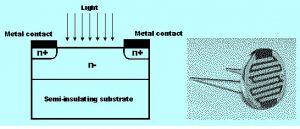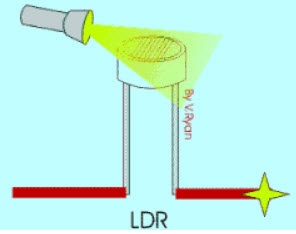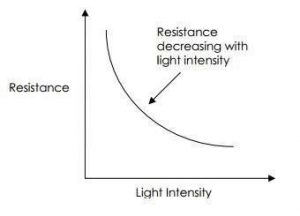Detection of light is a basic need for everything like plants, animals and even devices. Device researchers have worked on techniques for light detection and developed devices that offer excellent performance. Light is an electromagnetic radiation with a much shorter wavelength and higher frequency than radio waves. It is a quantum mechanical phenomena and comes in discrete particles called Photons.
An LDR or a photo resistor is a device which is made up of high resistance semiconductor material.
A light sensor is a passive sensor that is used to indicate the intensity of the light by examining the radiant energy that exists in a certain range of frequencies. In the spectrum of electromagnetic waves, the ranges of frequencies that are used to detect using a sensor are between infrared to visible and up to ultraviolet.
Light sensors convert the light energy in the form of photons to electrical energy in the form of electrons. Hence, they are also called as Photo Sensors or Photo Detectors or Photo Electric Devices.
Light sensors or Photo Sensors can be classed into three types based on the physical quantity that is affected. The main classes are Photo resistors, photo voltaic and photo emitters. Photo emitters generate electricity when exposed to light. Photo resistors change their electrical properties when illuminated. Based on the above classes, the following classification of devices can be made.
Photo Emissive Cells: These types of photo devices release free electrons from light sensitive materials when strike by a photon of sufficient energy. The generally used light sensitive material is Caesium. The energy of a photon is dependent on the wavelength or frequency of the light.
The equation of energy of a photon is
E = hc / λ
Here,
h is Planck’s constant (h = 6.626 * 10-34 J s),
c is velocity of light (c = 3 * 108 m / s)
λ is wavelength of the light.
If the frequency of the light is higher, the energy of the photon is higher.
Photo Conductive Cells: These types of photo devices vary their electrical property of resistance when they are subjected to light. The common type of photoconductive material is Cadmium Sulphide (CdS) which is used in Light Dependent Resistor Photocells. The photoconductivity in these cells results from light hitting a semiconductor material which controls the flow of current through it. For a given applied voltage, when the intensity of the light increases, the current also increases.
Photo Voltaic Cells: These types of photo devices generate a potential or an emf that is proportional to the energy of the radiant light. Solar Cells are a common type of photo voltaic cells and use Selenium as the photo voltaic material. They are made by sandwiching two semiconductor materials and when light energy is incident on them, a voltage of approximately 0.5 V is generated.
When subjected to light energy, a Photoconductive light sensor will change its physical property. Photo Resistor is a common type of photoconductive device. Photo resistor is a semiconductor device that uses light energy to control the flow of electrons and therefore the flow of current in them.
The most common type of photoconductive cell is a Light Dependent Resistor or LDR. As the name implies, a Light Dependent Resistor is a semiconductor device that changes its electrical resistance depending on the presence of light. A Light Dependent Resistor changes its electrical resistance from a high value of several thousand Ohms in the dark to only a few hundreds of Ohms when light is incident on it by creating electron – hole pairs in the material.
The most common material used to make a Light Dependent Resistor is Cadmium Sulphide (CdS). Other materials like Lead Sulphide (PbS), Indium Antimonide (InSb) or Lead Selenide (PbSe) can also be used as the semiconductor substrate.
Cadmium Sulphide is used in Photo resistors that are sensitive to near infrared and visible light. The reason it is used is because of its close resemblance of its spectral response curve to that of the human eye. It can be controlled by a simple, light source like a flash light and the peak sensitive wavelength of Cadmium Sulphide material is about 560 nm to 600 nm in the visible spectral range.
Cadmium Sulphide is deposited as a thread pattern on an insulator in the shape of a zigzag line as shown below.

Light Dependent Resistor
Construction of a LDR
The construction of a LDR includes a light sensitive material which is placed on an insulating substrate like as ceramic. The material is placed in a zigzag shape in order to get the required power rating and resistance. The area of zigzag separates the metal placed areas into two regions.

Construction of a LDR
Where the Ohmic contacts are made either on the sides of the area. The resistances of the contacts must be as less as possible to make sure that the resistance, mainly varies due to the light effect only. The use of lead & cadmium materials are avoided as they are injurious to the environment.
Working Principle of Light Dependent Resistor
The working principle of an LDR is photo conductivity, that is nothing but an optical phenomenon.When the light is absorbed by the material then the conductivity of the material reduces. When the light falls on the LDR, then the electrons in the valence band of the material are eager to the conduction band. But, the photons in the incident light must have energy superior than the band gap of the material to make the electrons jump from one band to another band (valance to conduction).

LDR Working Principle
Hence, when light having ample energy, more electrons are excited to the conduction band which grades in a large number of charge carriers. When the effect of this process and the flow of current starts flowing more, the resistance of the device decreases.

Variation in resistance with changing light intensity
Fig. Typical LDR resistance vs light intensity graph
The most common type of LDR has a resistance that falls with an increase in the light intensity falling upon the device (as shown in the image above). The resistance of an LDR may typically have the following resistances:
Daylight= 5000Ω
Dark= 20000000Ω
You can therefore see that there is a large variation between these figures. If you plotted this variation on a graph you would get something similar to that shown by the graph shown above.
Light Dependent Resistor Circuit
The sensitivity of the LDR switch is fairly low. To increase the sensitivity of light sensing, few modifications can be applied. The fixed resistor R1 is replaced with a potentiometer VR1. The transistor is replaced with an Operational Amplifier and the light dependent resistor is incorporated into a Wheatstone bridge. The new and more sensitive light sensing circuit using a light dependent resistor is shown below.

The resistors LDR, VR1, R1 and R2 will form a Wheatstone bridge. The sides of bridge LDR – VR1 and R1¬ – R2 form a potential divider with output voltages V1 and V2. These voltages are connected to non-inverting and inverting inputs of the operational amplifier respectively. The operational amplifier is operated as a differential amplifier whose output is a function of the difference between the two input voltages V1 and V2. This is also known as a voltage comparator with feedback. The feedback resistor Rf is used to provide required voltage gain.
The output of the operational amplifier is connected to a relay which can control an external circuit. When the voltage V1 due to light sensing by LDR falls below the voltage V2, which acts as a reference voltage, the output of the amplifier changes its state. This causes the relay to activate and the load is switched on.
As the intensity of the light increases, the output switches back and the relay is turned off.
Here the relay is turned on when the intensity of light is less. The operation can be reversed by reversing the positions of the light detecting resistor and potentiometer. Now the relay is turned on when the light level increases and exceeds the level set by the reference voltage.
Advantages
LDR’s are cheap and are readily available in many sizes and shapes. Practical LDRs are available in a variety of sizes and package styles, the most popular size having a face diameter of roughly 10 mm. They need very small power and voltage for its operation.
Applications of LDR
Light dependent resistors are simple and low cost devices. These devices are used where there is a need to sense the presence and absence of light is necessary. These resistors are used as light sensors and the applications of LDR mainly include alarm locks, street lights, light intensity meters, burglar alarm circuits. For better understanding of this concept, here we have explained one project namely; power conserving of intensity controlled street lights using LDR.











